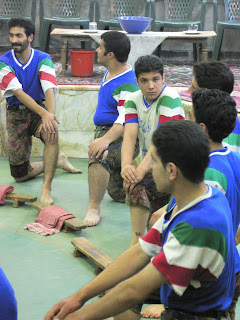More from my 2006 travel to Iran -- Isfahan, continued:
 |
| Isfahan's Imam Square |
Next, we found our way to the city’s central attraction: Imam Square, at 500 by 150 meters one of the world’s largest such open spaces (after Tiananmen Square in Beijing, and ahead of Red Square in Moscow) The Square is the scene of parades, military reviews, polo games and festivals over the centuries. Couples or families take rides in carriages like those that ply Central Park. There we chanced to meet Coleman Barkes and Robert Bly, well-known in the West for their own writing, and as translators of Persian literature. Barkes has been partly responsible for Rumi’s being one of the best-selling poets in the United States. They were in Iran to be honored for their work at a special ceremony.
 |
| Ali Qapu Palace's music room |
The six-story Ali Qapu palace gave us a good vantage-point from which to view the square; on one of the higher floors, we visited the old “music room”, where the walls are lacy with cut-outs in the shape of musical instruments, giving it enhanced acoustic qualities as well as visual interest.
 |
| Sheikh Loftollah Mosque |
Sheikh Loftfollah Mosque, like all the extant temples built since the time when Muslims conquered Sassanid Iran in 642 CE, was filled with geometric decorations of stupendous variety and intricacy; some ceramic decorative elements were so large that we couldn’t comprehend how they could have been fired – the kiln would have had be large enough to accommodate a single delicate piece of clay sixty feet in length.
§ § § § §
Our guide took us to the shop of noted miniaturist Mr. Hossein Fallahi, to see examples of this pictorial art which flourished despite Islamic prohibition of representative art. Fallahi gave us a concise description and demonstration of how this exacting work is done. Most often, such paintings are presented in frames which use another typically Esfahani art -- "khatam" -- the intricate, multi-color inlay work that one often sees on boxes and desk pieces.
§ § § § §
Later, we wandered individually through the bazaar, both for the bargains and for the interactions with merchants and other customers, wandered down quiet streets, or had tea, served in a small glass with lump sugar, at a neighborhood coffeehouse.
§ § § § §
 |
| Novice strongmen |
The Zoorkhaneh (“house of strength”), which some of us visited in the evening, is an institution dating from the days of Mogul dominance, when preparation for war by the Persians was prohibited. The people found in it a way to retain martial skills, while cloaking the activity in enough artistic and religious traditions that its underlying purpose was obscured. In the form that one sees today, the zoorkhane members carry out a routine of exercises that are introduced and punctuated by prayers, chants or recitations, and accompanied by the beat of drum from their morshed (the coach/leader). It is customary for him to ask for a traditional prayer for the Prophet Mohammad and his family. This evening, he asked everyone to pray for the health of the guests from America, and he asked those present to respond so loudly that their voices would be heard in Washington D.C.. The various kinds of apparatus each have their origin in the movements (and muscle groups) needed for archery, swordplay and hand-to-hand combat. Those who excel are known as pahlavans, or champions, and the photos of the current group’s most illustrious predecessors fill the walls of the high-ceilinged practice/performance space.
At the climax of the evening’s routine, men swung, tossed and juggled long clubs of polished wood that weighed up to nearly 90 pounds each, and twirled like the Sufi mystics called darvish (the famous “whirling dervish”), until dizzy. This exercise prepared the warriors of old to defend themselves until their last breath against lopsided odds. We could see that even five or ten men would have difficulty subduing a pahlavan wielding two swords and swinging them in a circle with his nimble feet at the vortex.
 |
| Detail, Natanz Mosque |
Natanz -- for us, a way-station on our way to Qom -- has become known in the West as a symbol of Iran’s entry into the nuclear “club.” Ironically, we (the United States) were responsible for encouraging Iran to begin a nuclear program in the first place, back when the Shah was in power, and according to James Risen, who won a Pulitzer Prize for work at the New York Times which he published in a book called State of War, the CIA gave Iran plans to build a nuclear bomb. (If that is in fact the case, then it would surely have been a violation of the Non-Proliferation Treaty.)
Dafna Linzer of the Washington Post reported that in 1976 the Ford administration “endorsed Iranian plans to build a massive nuclear energy industry, but also worked hard to complete a multibillion-dollar deal that would have given Tehran control of large quantities of plutonium and enriched uranium - the two pathways to a nuclear bomb.” Noam Chomsky pointed out recently that “the top planners of the Bush administration, who are now denouncing these programmes, were then in key national security posts: Dick Cheney, Donald Rumsfeld and Paul Wolfowitz.”
As evidence of the persistence and patience that is a part of Persian culture, near Natanz is grown the saffron plant, a type of crocus that yields that most decorative – and expensive – typically Persian spice. For eleven-and-one-half months the farmer waits. Then the plant pushes a shoot aboveground which lasts for just fifteen days. For only 72 hours it blooms, and it is then that the saffron must be harvested – a miniscule amount from the stamen of each flower.
No comments:
Post a Comment